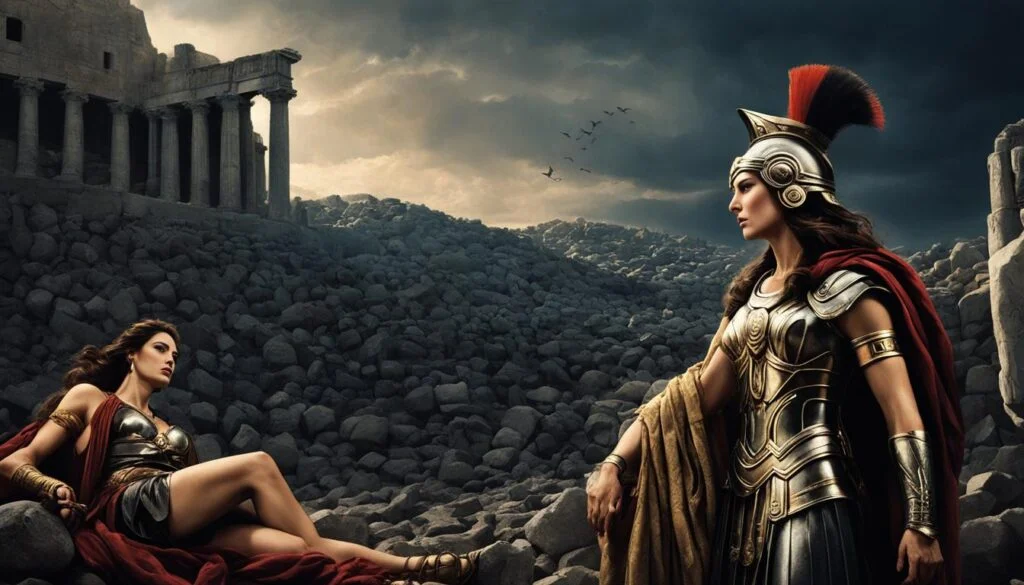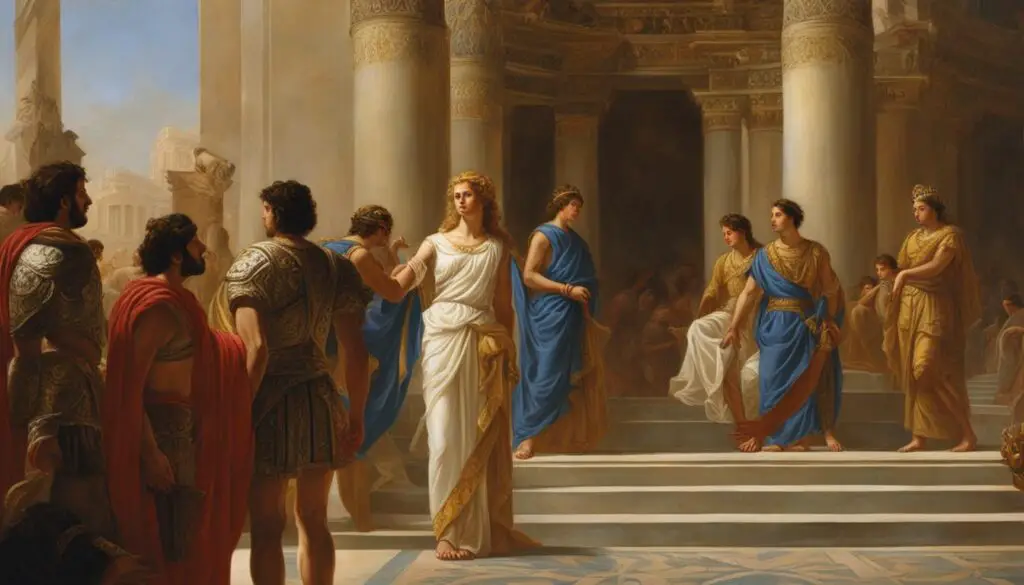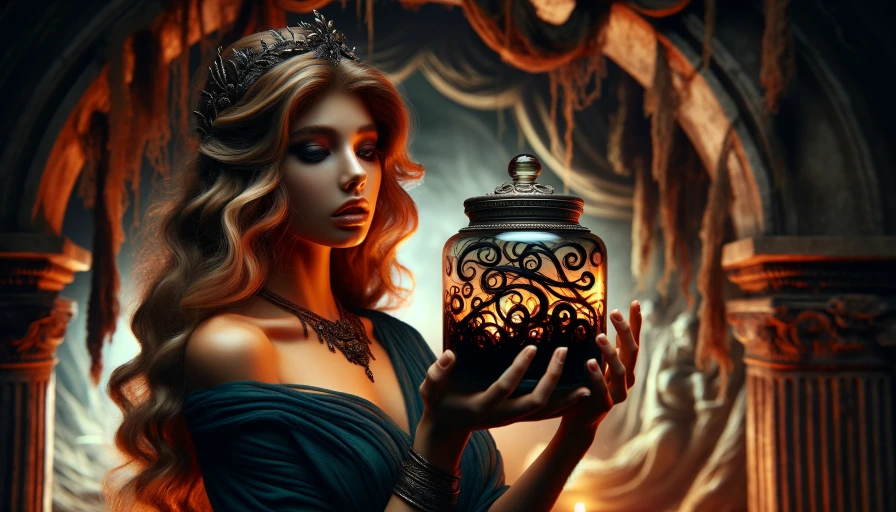The story of Helen of Troy has fascinated people throughout history, captivating them with its tales of beauty, love, and war.
Who is Helen in Greek mythology? Helen, also known as Helen of Troy, is a figure shrouded in mystery and intrigue.
Her role in the Trojan War and her mythological origins make her a central character in ancient Greek lore.
Helen’s story begins with her birth as the daughter of Zeus, the king of the gods, and Leda, the queen of Sparta.
Her extraordinary beauty and royal status made her a coveted prize and led to her marriage to King Menelaus of Sparta.
However, her abduction by Paris of Troy sparked the Trojan War, a ten-year-long conflict between the Greeks and the Trojans.
Key Takeaways:
- Helen of Troy is a captivating figure in Greek mythology, known for her beauty and her role in the Trojan War.
- She is the daughter of Zeus and Leda, the queen of Sparta.
- Helen’s abduction by Paris of Troy led to the ten-year-long Trojan War.
- Her story raises questions about beauty, desire, and the consequences of one’s actions.
- The mythological origins and complex portrayal of Helen continue to spark fascination and debate.
The Mythological Ancestry of Helen of Troy
According to Greek mythology, Helen of Troy is often regarded as the daughter of Zeus and Leda.
Leda, the queen of Sparta, was visited by Zeus in the form of a swan, resulting in the birth of Helen and her siblings Pollux, Clytemnestra, and Castor.
Helen’s unmatched beauty and regal status made her a highly sought-after prize, eventually leading to her marriage to King Menelaus of Sparta.
However, her fateful abduction by Paris of Troy triggered a series of events that would ultimately culminate in the legendary Trojan War.
As depicted in various ancient texts and artworks, Helen’s captivating tale continues to captivate audiences, continuing to raise questions about love, desire, and the consequences of one’s actions.
Helen in Homer’s Iliad and Odyssey

In Homer’s epic poems, the Iliad and the Odyssey, Helen of Troy assumes a significant yet limited role.
In the Iliad, she is characterized as a woman of unparalleled beauty, and her elopement becomes the catalyst for the legendary Trojan War.
Her portrayal evokes a complex range of emotions from regret and shame to pity among the audience.
However, it is in the Odyssey that Helen’s character is further examined. The poet implies that she played a clandestine role in the iconic Trojan horse episode.
Here, it is suggested that Helen used her allure and cunning to deceive the Trojans, ultimately leading to the Greeks’ victory.
This connection solidifies Helen’s involvement in the conflict, showcasing her agency and strategic thinking.
Helen of Troy in Euripides’ Plays

Euripides, a renowned Greek playwright, explored the character of Helen of Troy in several of his tragic plays.
In works such as The Trojan Women and Orestes, Helen is portrayed as a condemned figure, held responsible for her actions during the Trojan War.
These plays emphasize her role in causing destruction and the suffering of others.
However, Euripides also presented an alternative perspective in his play Helen. In this unique rendition, Euripides offers an intriguing twist to the traditional narrative.
He suggests that Helen was actually in Egypt during the Trojan War, while a phantom Helen, created by the gods, was the one who caused chaos and destruction.
This portrayal delves into the complexities of Helen’s character and raises questions about her true culpability in the war.
Throughout Euripides’ plays, the character of Helen serves as a fascinating study of human nature, exploring the themes of guilt, redemption, and the complexities of one’s actions.
While some portrayals condemn her for her supposed role in the war, others challenge the audience to question their preconceived notions and consider the possibility of a more nuanced portrayal.
Helen in the Works of Sappho

Sappho, an ancient Greek poet, offers a unique perspective on Helen of Troy in one of her poems.
Unlike other portrayals, Sappho does not pass judgment on Helen, but instead emphasizes her agency and the power of her love.
This portrayal presents Helen as a woman who followed her heart, despite the dire consequences that ensued.
Sappho’s poem compares Helen to Anaktoria, Sappho’s own love interest, creating a parallel between their experiences and emotions.
Through this comparison, Sappho underscores the significance of love and desire in shaping the lives of these influential women.
In her depiction of Helen, Sappho challenges the conventional narratives surrounding the infamous figure.
By highlighting Helen’s agency as she follows her heart, Sappho presents a nuanced portrayal that encourages reflection on the complexities of human emotion and the choices individuals make.
The visual depiction of Helen of Troy in this image captures the essence of her enigmatic character, as portrayed by Sappho.
The image showcases the allure and beauty that lured countless admirers and set in motion the events that changed the course of history.
Helen of Troy in Greek and Roman Art

Greek and Roman artists have long been captivated by the legendary beauty of Helen of Troy, and as a result, her image has been immortalized in art throughout the ages.
These depictions often emphasize her physical appearance, portraying her as a figure of great beauty and allure.
In Greek pottery, a popular medium for artistic expression, Helen is frequently depicted in various scenes from mythology and epic poetry.
Artists would employ techniques such as the black-figure technique, which involved painting black figures on a clay surface, to bring out the details of Helen’s features and enhance her radiance.
The Roman artists, too, were entranced by the story of Helen. She is often portrayed in intricate mosaics, sculptures, and frescoes that adorned the walls of grand villas and public spaces.
These artworks aimed to capture every aspect of Helen’s beauty, from her flowing hair to her captivating gaze.
Whether in the elegant simplicity of Greek vase painting or the grandeur of Roman sculptures, Helen’s portrayal in Greek and Roman art remains an enduring testament to the allure and mystery that still surrounds her name.
Helen’s Complex Legacy

Helen’s portrayal in literature and art has left a lasting, complex legacy. While she is often remembered for her unparalleled beauty and her pivotal role in the Trojan War, interpretations of her character have evolved over time.
From being condemned as an adulteress and a catalyst for war in Greek tragedies to being absolved of blame and seen as a victim of circumstances, Helen’s legacy is one that continues to fascinate and spark debate.
In ancient Greek tragedies, Helen was often depicted as an immoral and treacherous figure, responsible for the destruction brought upon Troy.
Her beauty and allure were seen as dangerous and capable of inciting chaos. However, more recent interpretations have sought to humanize Helen, exploring the complexities of her character and the circumstances that may have influenced her choices.
In literature, Helen has been portrayed as a woman who found herself torn between loyalty to her husband and the magnetic pull of love.
While her actions may have triggered a decade-long war, some argue that Helen was ultimately a victim of the gods’ whims and the societal expectations imposed upon her.
Artistic representations of Helen have further contributed to her complex legacy. Paintings, sculptures, and other visual mediums have captured her beauty and made her an iconic symbol of desire.
Artists have sought to capture the essence of Helen, allowing her image to transcend time and captivate audiences across centuries.
One of the most notable examples is the ancient Greek vase painting technique known as the black-figure technique, which emphasized Helen’s attractiveness and elevated her status as a subject of artistic inspiration.
Today, the discussion surrounding Helen’s legacy continues in various forms of media and literature.
Her enigmatic character and the moral implications of her choices prompt reflection on themes such as beauty, desire, and the consequences of one’s actions.
In conclusion, Helen’s complex portrayal in literature and art has contributed to her enduring legacy.
As interpretations evolve, her character continues to spark fascination and debate, leaving an indelible mark on the cultural landscape.
Helen’s Influence in Modern Culture

Helen of Troy continues to captivate audiences in modern culture, leaving an indelible mark on literature and film.
Her story has been retold in numerous books, movies, and plays, exploring different facets of her character and the profound impact she had on history.
Literature:
In literature, Helen of Troy is a recurrent theme, with authors delving into her complex persona and role in the Trojan War.
Books like “The Song of Achilles” by Madeline Miller and “Helen of Troy: A Novel” by Margaret George bring her story to life, offering unique perspectives on her motivations and the consequences of her actions.
- “The Song of Achilles”: This novel by Madeline Miller reimagines the events of the Trojan War through the lens of Patroclus, Achilles’ close companion. Helen’s allure and influence are vividly portrayed, showcasing her impact on the lives of those around her.
. - “Helen of Troy: A Novel”: Margaret George’s book provides a comprehensive account of Helen’s life, exploring her relationships, struggles, and the far-reaching consequences of her fabled beauty.
Film:
In the realm of cinema, Helen of Troy’s story has been adapted into breathtaking films that bring the epic tale to the big screen.
The 2004 movie “Troy,” starring Brad Pitt as Achilles and Diane Kruger as Helen, presents a visually stunning depiction of the Trojan War, with a particular emphasis on Helen’s pivotal role in sparking the conflict.
Contemporary Adaptations:
Modern authors continue to draw inspiration from Helen of Troy, incorporating her character into contemporary novels and exploring her enduring appeal.
Works such as “Circe” by Madeline Miller and “Helen of Troy Rising” by Sara Stamey offer fresh perspectives on Helen’s story, intertwining mythology with innovation.
- “Circe”: Madeline Miller’s novel tells the story of the sorceress Circe, including her encounters with famous mythological figures like Helen of Troy. This reinterpretation introduces a nuanced portrayal of Helen, shedding light on her complexities as a character.
. - “Helen of Troy Rising”: Sara Stamey’s novel takes a speculative approach, transporting Helen to the modern world and exploring her journey as she navigates contemporary challenges. Through this reimagining, readers gain insight into the legacy and enduring allure of Helen of Troy.
From literature to film, Helen of Troy’s presence resonates across artistic mediums. Her impact continues to captivate audiences and inspire further exploration of her timeless story, ensuring her enduring influence in modern culture.
Conclusion
The story of Helen of Troy is a captivating tale that continues to enthrall audiences with its timeless themes of beauty, love, and tragedy.
From her mythological origins as the daughter of Zeus and Leda to her role in the Trojan War, Helen’s complex character raises profound questions about desire and the consequences of one’s actions.
Throughout ancient literature and art, Helen’s beauty has been depicted with great reverence, showcasing her as a symbol of allure and distinction.
From her portrayal in the works of Homer, where she evokes both pity and remorse, to Euripides’ exploration of her culpability in the war, Helen’s character is multi-dimensional and thought-provoking.
Even in modern culture, Helen’s influence remains prevalent. She has been the subject of countless books, films, and plays, serving as a muse for artists and a perennial source of fascination.
The story of Helen of Troy not only captivates with its mythical origins but also challenges our understanding of beauty, desire, and the complexities of human nature.




